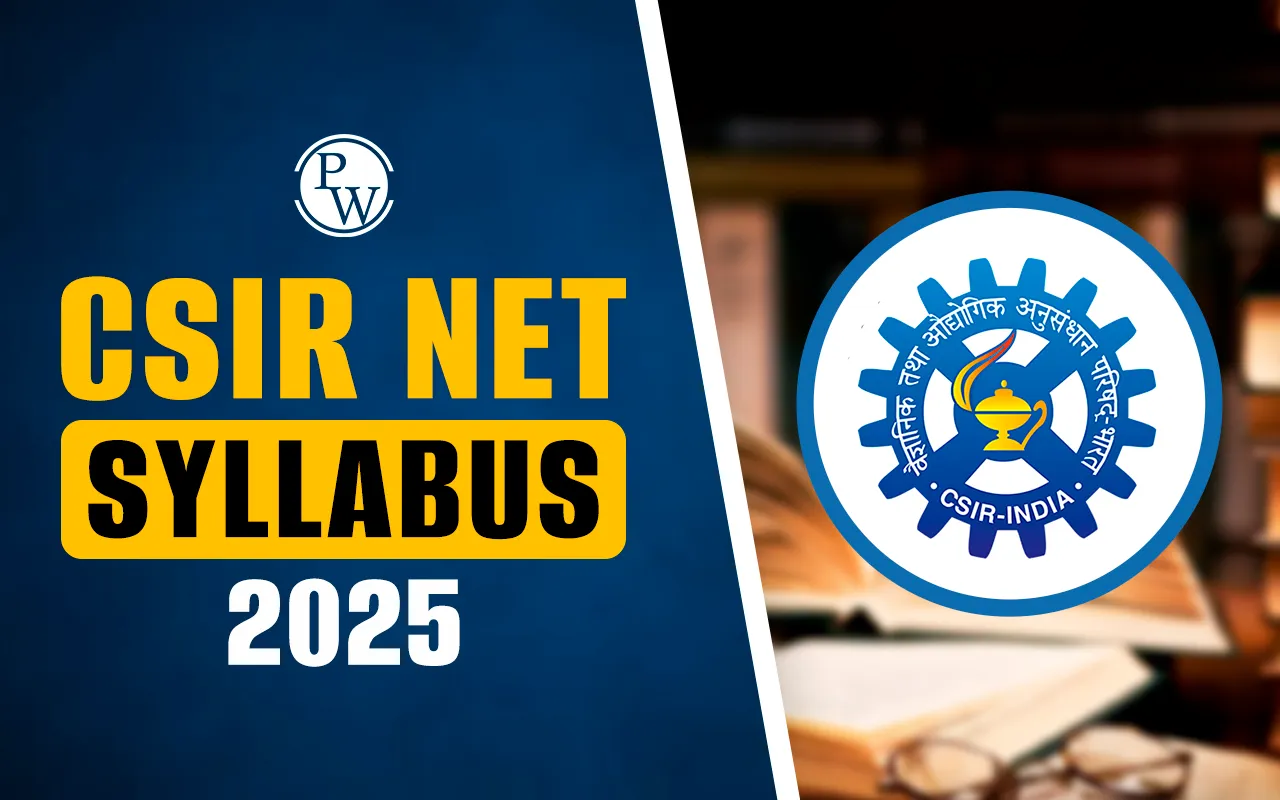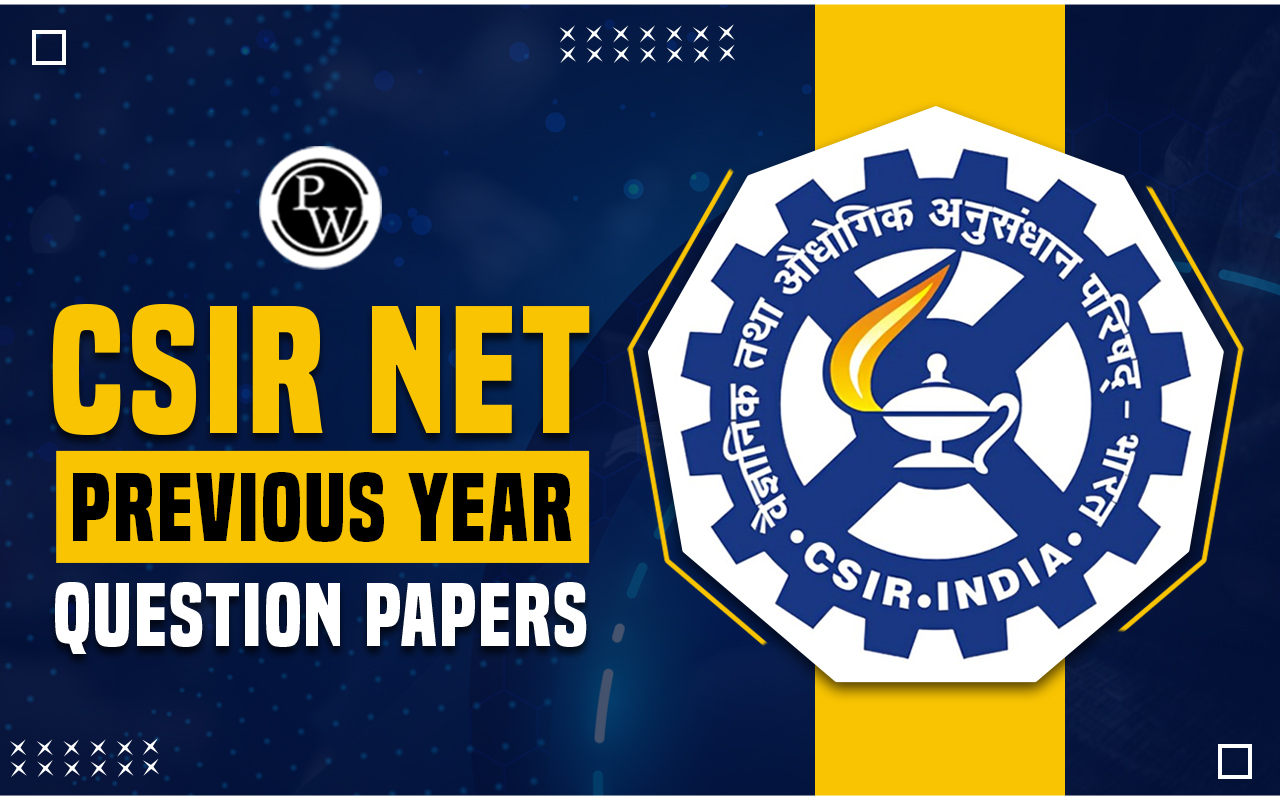

To prepare well for the CSIR GATE JRF 2023 , candidates need to be aware of the full CSIR JRF GATE Syllabus 2023. The Council of Scientific & Industrial Research (CSIR) announces an annual notification to select eligible candidates for the Junior Research Fellowship (JRF) program based on their GATE scores.
CSIR JRF GATE presents a fantastic opportunity for those who have completed their post-graduation in Biotechnology Science, Physical Science, and Chemical Science.CSIR JRF GATE Syllabus 2023
CSIR JRF GATE Syllabus covers all subjects. Keep in mind that the syllabus for GATE JRF is slightly different from that of graduation/post-graduation. It includes a compulsory General Aptitude section for each paper. Stay updated with the syllabus, as IIT Kharagpur released it for GATE 2022. Understanding the CSIR JRF GATE syllabus will give you insights into the exam's nature and structure. The exam lasts for 3 hours and is conducted online through CBT (Computer-Based Test) mode. Each paper comprises two sections: General Aptitude and Specific Subject. Below, you will find the syllabus for various subjects:- Biotechnology
- Chemical Engineering
- Chemistry
- Chemistry Syllabus
- Biochemistry Syllabus
- Botany
- Microbiology
- Food Technology
- Zoology
CSIR JRF GATE Syllabus Biology
CSIR JRF GATE 2023 Biotechnology syllabus consists of 7 main sections. You can find the detailed syllabus for GATE Biotechnology below. It includes the CSIR JRF GATE Syllabus 2023 .| CSIR JRF GATE Syllabus 2023 Biology | ||
| Section | Topics | Sub Topics |
| General Aptitude | Verbal Aptitude | Basic English grammar: Tenses, articles, adjectives, prepositions, conjunctions, verb-noun agreement, and other parts of speech, Basic vocabulary: Words, idioms, and phrases in context, Reading and comprehension, Narrative sequencing. |
| Quantitative Aptitude | Data interpretation: Data graphs (bar graphs, pie charts, and other graphs representing data), 2- and 3-dimensional plots, maps, and tables, Numerical computation and estimation: Ratios, percentages, powers, exponents and logarithms, permutations and combinations, and series, Mensuration, and geometry, Elementary statistics, and probability. | |
| Analytical Aptitude | Logic: Deduction and induction, Analogy, Numerical relations, and reasoning. | |
| Engineering Mathematics | Calculus | Limits, continuity, and differentiability; partial derivatives, maxima, and minima; sequences and series; test for convergence |
| Probability And Statistics | Mean, median, mode, and standard deviation; random variables; Poisson, normal, and binomial distributions; correlation and regression analysis. | |
| General Biology | Biochemistry | Biomolecules-structure and function; biological membranes-structure, membrane channels, and pumps, molecular motors, action potential, and transport processes; basic concepts and regulation of the metabolism of carbohydrates, lipids,Amino acids, and nucleic acids; photosynthesis, respiration, and electron transport chain, Enzymes-classification, catalytic, and regulatory strategies; enzyme kinetics-Michaelis-Menten equation; enzyme inhibition-competitive, non-competitive, and uncompetitive inhibition |
| Immunology | Innate and adaptive immunity, humoral and cell-mediated immunity; antibody structure and function; molecular basis of antibody diversity; T cell and B cell development; antigen-antibody reaction; complement; primary and secondary lymphoid organs, Major histocompatibility complex (MHC); antigen processing and presentation; polyclonal and monoclonal antibody; regulation of immune response; immune tolerance; hypersensitivity; autoimmunity; graft versus host reaction; immunization and vaccines. | |
| Bioprocess engineering and process biotechnology | Bioreactor Engineering | Rate law, zero, and first-order kinetics; ideal reactors-batch, mixed flow, and plug flow; enzyme immobilization, diffusion effects-Thiele modulus, effectiveness factor, Damkohler number; kinetics of cell growth, Substrate utilization, and product formation; structured and unstructured models; batch, fed-batch, and continuous processes; microbial and enzyme reactors; optimization and scale up. |
| Instrumentation And Process Control | Pressure, temperature, and flow measurement devices; valves; first order and second order systems; feedback and feed-forward control; types of controllers-proportional, derivative, and integral control, tuning of controllers | |
| Plant, animal, and microbial biotechnology | Plants | Totipotency; regeneration of plants; plant growth regulators and elicitors; tissue culture and cell suspension culture system-methodology, the kinetics of growth and nutrient optimization; production of secondary metabolites; hairy root culture, Plant products of industrial importance; artificial seeds; somaclonal variation; protoplast, protoplast fusion-somatic hybrid, and cybrid; transgenic plants-direct and indirect methods of gene transfer techniques; selection marker and reporter gene, Plastid transformation |
| Microbes | Production of biomass and primary/ secondary metabolites-biofuels, bioplastics, industrial enzymes, antibiotics; large-scale production and purification of recombinant proteins and metabolites; clinical-, food-, and industrial microbiology, Screening strategies for new products | |
| Genetics, cellular, and molecular biology | Cell Biology | Prokaryotic and eukaryotic cell structure; cell cycle and cell growth control; cell-cell communication; cell signaling and signal transduction; post-translational modifications; protein trafficking; cell death and autophagy; extra-cellular matrix |
| Molecular Biology | Molecular structure of genes and chromosomes; mutations and mutagenesis; regulation of gene expression; nucleic acid-replication, transcription, splicing, translation, and their regulatory mechanisms; Non-coding and microRNA; RNA interference, DNA damage, and repair. | |
| Bioprocess Engineering and Process Biotechnology | Upstream And Downstream Processing | Media formulation and optimization; sterilization of air and media; filtration-membrane filtration, ultrafiltration; centrifugation-high speed and ultra; cell disruption; principles of chromatography-ion exchange, gel filtration, hydrophobic interaction, Affinity, GC, HPLC, and FPLC; extraction, adsorption, and drying. |
| Bioreaction Engineering | Rate law, zero, and first-order kinetics; ideal reactors-batch, mixed flow, and plug flow; enzyme immobilization, diffusion effects-Thiele modulus, effectiveness factor, Damkohler number; kinetics of cell growth, Substrate utilization, and product formation; structured and unstructured models; batch, fed-batch, and continuous processes; microbial and enzyme reactors; optimization and scale up. | |
| Fundamentals of biological engineering | Transport Process | Newtonian and non-Newtonian fluids, fluid flow-laminar and turbulent; mixing in bioreactors, mixing time; molecular Diffusion and film theory; oxygen transfer and uptake in a bioreactor, kLa and its measurement; conductive and convective heat transfer, LMTD, Overall heat transfer coefficient; heat exchangers |
| Classic Thermodynamics and Bioenergetics | Laws of thermodynamics; solution thermodynamics; phase equilibrium, reaction equilibrium; ligand binding; membrane potential; energetics of metabolic pathways, oxidation, and reduction reactions | |
CSIR JRF GATE Syllabus Chemical Engineering
Check the syllabus for Chemical Engineering here. The conducting body will include questions based on the topics provided below, as per the CSIR JRF GATE Syllabus 2023.| CSIR JRF GATE Syllabus 2023 Chemical Engineering | ||
| Section | Topics | Sub Topics |
| Engineering Mathematics | Differential Equation | First order equations (linear and non-linear), higher order linear differential equations with constant coefficients, Cauchy's and Euler's equations, initial and boundary value problems, Laplace transforms, Solutions of one-dimensional heat and wave equations, and Laplace equation. |
| Probability and Statistics | Definitions of probability and sampling theorems, conditional probability, mean, median, mode and standard deviation, random variables, Poisson, normal and binomial distributions, and linear regression analysis. | |
| Numerical Methods | Numerical solutions of linear and non-linear algebraic equations, Integration by trapezoidal and Simpson's rule, Single and multi-step methods for the numerical solution of differential equations. | |
| Process calculations and thermodynamics | Thermodynamics Properties of a pure substance | Equation of state and residual properties |
| Phase Equilibria | Predicting VLE of systems; chemical reaction equilibrium | |
| Properties Of Mixture | Partial molar properties, fugacity, excess properties, and activity coefficients | |
| Fluid mechanics and mechanical operations | Fluid Mechanics And Mechanical Operations | Fluid Status, Newtonian and non-Newtonian fluids, Shell-balances including the differential form of Bernoulli equation and energy balance, Equation of motion, Macroscopic friction factors, Dimensional analysis and similitude, Flow meters, Turbulent flow, Size reduction and classification of solid particles, Thickening and classification, Agitation and mixing, Conveying of solids |
| Mass transfer | Mass Transfer | Molecular Diffusion In Fluids, Mass transfer coefficients, Penetration and surface renewal theories, Heat and mass transfer analogies, Stage-wise and continuous contacting and stage efficiencies, Design and operation of equipment for distillation, Dehumidification and adsorption, Membrane separations (micro-filtration, ultra-filtration, nano-filtration and reverse osmosis) |
| Chemical technology | Chemical Technology | Fertilizers (Ammonia, Urea, SSP, TSP), Natural products industries (pulp and paper, sugar, oil, and fats), Polymerization industries (polyethylene, polypropylene, PVC, and polyester synthetic fibers), Inorganic chemical industries (sulphuric acid, phosphoric acid, Chlor-alkali industry) |
CSIR JRF GATE Syllabus 2023 Chemistry
Check out the Chemistry syllabus for CSIR GATE JRF here, which covers topics from physical chemistry, inorganic chemistry, and organic chemistry as per the CSIR JRF Syllabus 2023.| CSIR JRF GATE Syllabus 2023 Chemistry | ||
| Sections | Topics | Subtopics |
| Physical chemistry | Structure | Particle in a box: Infinite and finite square wells; the concept of tunnelling; particle in 1D, 2D, and 3D-box; applications, Postulates of quantum mechanics, Time-dependent and time-independent Schrödinger equations, harmonic oscillator: Harmonic and anharmonic potentials; Hermite polynomials, Hydrogen and hydrogen-like atoms: Atomic orbitals; radial distribution function, Approximation methods: Variation method and secular determinants; first-order perturbation techniques, Group theory: Symmetry elements and operations; point groups and character tables; internal coordinates and vibrational modes; symmetry adapted linear combination of atomic orbitals (LCAO-MO); construction of hybrid orbitals using symmetry aspects |
| Equilibrium | Laws of thermodynamics, Thermodynamic functions, and their relationships: Gibbs-Helmholtz and Maxwell relations, Gibbs-Duhem equation, Can't Hoff equation, Criteria of spontaneity and equilibrium, Fugacity, activity and activity coefficients, Ideal and Non-ideal solutions, Raoult's law and Henry's law, chemical equilibria, Nernst Equation and its application, the relationship between electrode potential and thermodynamic quantities, potentiometric and conductometric titrations, the Phase diagram of one component systems: CO2, H2O, S; two-component systems: Liquid- vapour, liquid-liquid, and solid-liquid systems. | |
| Surface and interfaces | Physisorption and Chemisorption, Langmuir, Freundlich, and Brunauer-Emmett-Teller (BET) isotherms, Surface tension, viscosity, Physical chemistry of colloids, micelles, and macromolecules, Self-assembly | |
| Inorganic chemistry | Main Group Elements | Hydrides, halides, oxides, oxoacids, nitrides, sulfides-shapes and reactivity, structure and bonding of boranes, carboranes, silicones, silicates, boron nitride, borazines, and phosphazenes, Chemistry of noble gases, pseudohalogens, and interhalogen compounds,acid-base concepts, and principles (Lewis, Brønsted, HSAB, and acid-base catalysis) |
| Lanthanides and antacids | Periodic properties, spectra and magnetic properties, Recovery, | |
| Organometallics | 18-Electron rule; metal-alkyl, metal-carbonyl, metal-olefin, and metal-carbene complexes and metallocenes, Homogeneous catalysis-hydrogenation, hydroformylation, acetic acid synthesis, metathesis and olefin oxidation, Heterogeneous catalysis-Fischer-Tropsch reaction, Ziegler-Natta polymerization, Types of organometallic reactions | |
| Organic chemistry | Stereochemistry | Chirality and symmetry of organic molecules with or without chiral centers and determination of their absolute configurations, Relative stereochemistry in compounds having more than one stereogenic center, stereoselective and stereospecific synthesis, Configurational and conformational effects, atropisomerism, and neighboring group participation on reactivity and selectivity/ specificity, Conformational analysis of acyclic and cyclic compounds |
| Reaction Mechanism | We determine reaction mechanisms through kinetics, identification of products, intermediates, and isotopic labeling. Addition reactions to carbon-carbon and carbon-heteroatom (N and O) multiple bonds, reactive intermediates-carbocations, carbanions, carbenes, nitrenes, arynes, and free radicals, Molecular rearrangements. | |
| Biomolecules | Structure, properties, and reactions of mono-and di-saccharides, physicochemical properties of amino acids, chemical synthesis of peptides, chemical structure determination of peptides and proteins, Structural features of proteins, nucleic acids, lipids, steroids, terpenoids, carotenoids, and alkaloids. | |
CSIR JRF GATE Syllabus XL Chemistry
Candidates can check for the XL Chemistry Syllabus here.| CSIR JRF GATE Syllabus 2023 XL Chemistry | ||
| Section | Topics | Units |
| Atomic Structure And Periodicity | Atomic Structure And Periodicity | Planck's Quantum Theory, Wave-particle duality, Comparison between Bohr's model and quantum mechanical model of the hydrogen atom, Hund's rule and Pauli's exclusion principle, Periodic table, and periodic properties |
| Structure and bonding | Structure And Bonding | Oxides, Ionic and covalent bonding, MO and VB approaches for diatomic molecules, VSEPR theory and shape of molecules, Structure parameters such as bond length, bond angle, and bond energy, Ionic solids, ionic radii, and lattice energy (Born‐Haber cycle) |
| Chemical equilibrium | Chemical Equilibrium | Osmotic pressure, Elevation of boiling point and depression of freezing point, Ionic equilibrium in solution, Solubility product, Common ion effect, Equilibrium constants (Kc, Kp, and Kx) for homogeneous reactions |
| Electrochemistry | Electrochemistry | Conductance, Kohlrausch's law, Cell potentials, Thermodynamic aspects, and their applications, Nernst equation, EMF |
| Reaction kinetics | Reaction Kinetics | Rate Constant, Order of reaction, Activation energy, Catalysis, and elementary enzyme reactions, Zero, first, and second order kinetics, Reversible and irreversible inhibition of enzymes. |
| Thermodynamics | Thermodynamics | Internal Energy, Qualitative treatment of state and path functions, First law of thermodynamics, Reversible and irreversible processes, Internal energy, Kirchhoff equation, Second law of thermodynamics, Free energy change and spontaneity |
| Section | Topics | Units |
CSIR GATE JRF Syllabus XL Biochemistry
XL Biochemistry Syllabus is mentioned here.| CSIR GATE JRF Syllabus 2023 XL Biochemistry | |
| Section | Units |
| 1 | Organization of life, Structure, and function of biomolecules: Amino acids, carbohydrates, lipids, proteins, and nucleic acids, Protein structure, Folding/ misfolding and function, Haemoglobin, Ribonuclease A, Carboxypeptidase and chymotrypsin |
| 2 | Enzyme kinetics including its regulation and inhibition, Vitamins and coenzymes, Metabolic pathways and their regulation: Glycolysis, TCA cycle, pentose phosphate pathway, oxidative phosphorylation, gluconeogenesis, glycogen and fatty acid metabolism, Metabolism of nitrogen-containing compounds: Nitrogen fixation, amino acids and nucleotides, Metabolism and bioenergetics, Photosynthesis, Calvin cycle |
| 3 | Biochemical separation techniques: Ion exchange, size exclusion and affinity chromatography, centrifugation, Characterization of biomolecules by electrophoresis, UV-visible and fluorescence spectroscopy, Mass spectrometry |
| 4 | Cell structure and organelles, Biological membranes, Membrane assembly and protein targeting, Receptor-ligand interaction, Hormones and neurotransmitters |
| 5 | recombinant DNA technology and applications: PCR, site-directed mutagenesis, DNA-microarray, Next generation sequencing, Gene silencing, and editing, DNA damage, and repair |
| 6 | Immune system: Innate and adaptive, Immunological techniques: Immunodiffusion, immune-electrophoresis, RIA and ELISA, flow cytometry, Major histocompatibility complex, Antibody structure, function and diversity, monoclonal antibodies and their applications, B cell and T cell receptors, B cell, and T cell activation |
CSIR GATE JRF Syllabus XL Botany
Check the XL Botany syllabus here, which includes important topics such as plant anatomy, cell development, genetics and genomics, economics, and applied botany, following the ICAR JRF Syllabus 2023.| CSIR GATE JRF Syllabus 2023 XL Botany | |
| Topic | Subtopic |
| Plant Systematics | Botanical nomenclature, history of plant taxonomy, diversity and classification of plants, APG system of plant classification; phylogenetics and cladistics, molecular taxonomy and DNA barcoding; centers for plant taxonomy and herbaria in India |
| Plant Anatomy | Anatomy of root, stem, and leaves, floral organs, embryo, and young seedlings, primary and secondary meristems, stellar organization, vascular system and their ontogeny, xylem and phloem structure, secondary growth in plants and wood anatomy, Plant cell structure and differences from animal cells |
| Cell Development | The life cycle of an angiosperm, development of male and female gametophyte; cell fate determination and tissue patterning; spacing mechanisms in trichomes and stomata, Embryogenesis, organization and function of the shoot, and root apical meristems, Transition to flowering: Photoperiodism and vernalization, ABC model of floral organ patterning, pollen germination, double fertilization, seed development; xylem and phloem cell differentiation, photomorphogenesis; phytochrome, cryptochrome, phototropin, Role of auxin, cytokinin, gibberellins, and brassinosteroids on plant development |
| Plant Physiology and Biochemistry | Plant water relations, mechanisms of uptake and transport of water, ions, solutes from soil to plants, apoplastic and symplastic transport mechanisms, Mechanism of stomatal movements, nitrogen metabolism, photosynthesis; C3, C4, and CAM cycles, photorespiration, respiration: Glycolysis, TCA cycle, and electron transport chain, Plant responses and mechanisms of abiotic stresses including drought, salinity, freezing, and heat stress, metal toxicity; the of abscisic acid in abiotic stresses, Biosynthesis, Mechanism of action, and physiological effects of auxin, cytokinin, gibberellic acids, brassinosteroid, ethylene, strigolactone, abscisic acid, salicylic and jasmonic acid. |
| Genetics and genomics | Principles of Mendelian inheritance, linkage, recombination, genetic mapping; extrachromosomal heritage; introduction to epigenetics; gene silencing-transgene silencing, post-transcriptional gene silencing, miRNA and siRNA, Evolution and organization of eukaryotic genome structure, gene expression, gene mutation, and repair, chromosomal aberrations (numerical: Euploidy and aneuploidy, and structural: Deletion, duplication, inversion, translocation), transposons, Model organisms for functional genetics and genomics; introduction to transcriptomics, proteomics, and metabolomics |
| Plant Breeding, Genetics Modification, Genome Editing | Principles, methods-selection, hybridization, heterosis; male sterility, genetic maps, and molecular markers, embryo rescue, haploid and doubled haploids, plant tissue culture: Micropropagation, embryo culture, and in vitro regeneration, Plant tissue culture: Somatic embryogenesis, artificial seed, cryopreservation, somaclonal variation, somatic cell hybridization, marker-assisted selection, gene transfer methods viz. direct and vector-mediated, generation of transgenic plants, |
| Economic and applied botany | A general account of economically and medicinally essential plants-cereals, pulses, plants yielding fibers, timber, sugar, beverages, oils, rubber, pigments, dyes, gums, drugs, and narcotics, Effect of industrialization on agricultural botany such as plastic on fiber economy, Genetically modified crops and its regulation example Bt cotton, Bt brinjal, golden rice, etc., Major Indian cash crops |
| Plant Pathology | Nature and classification of plant diseases, diseases of important crops caused by fungi, bacteria, nematodes, and viruses, and their control measures (chemical and biological) mechanism (s) of pathogenesis, Resistance: Basal, systemic, induced systemic resistance, a gene for gene concept, Signaling pathways in plant defense response; salicylic acid (SA) and jasmonic acid (JA) in plant-pathogen and plant-herbivore interaction, necrosis; host-parasitic plant interaction (such as Cuscuta) |
| Ecology and Environment | Ecosystems-types, dynamics, degradation, biogeochemical cycles, ecological succession; food webs and energy flow through ecosystem; vegetation types of the world, Indian vegetation types and biogeographical zones, climate, and flora endemism, Pollution and global climate change, speciation and extinction, biodiversity and conservation strategies, ecological hotspots, afforestation, habitat restoration; plant interactions with other organisms; epiphytes, parasites, and endophytes. |
CSIR JRF GATE Syllabus XL Microbiology
Check the XL Microbiology syllabus here, which covers essential topics like historical perspective, prokaryotic cells, microbial metabolism, microbial ecology, and more, in accordance with the ICAR JRF Syllabus 2023.| CSIR JRF GATE Syllabus 2023 XL Microbiology | |
| Topic | Subtopics |
| Historical Perspective | Role of microorganisms in the transformation of organic matter and the causation of diseases, Landmark discoveries relevant to the field of microbiology, Role of microorganisms in the change of organic matter and the causation of diseases |
| Methods in microbiology | Principles of microbial nutrition, Enrichment culture techniques for isolation of microorganisms, Light-, phase contrast-, fluorescence-, and electron-microscopy, next-generation sequencing technologies in microbiology, Light-, phase contrast-, fluorescence-, and electron-microscopy |
| Microbial Taxonomy and diversity | Bacteria, archaea, and their broad classification, Molecular approaches to microbial taxonomy and phylogeny, Eukaryotic microbes: Yeasts, molds, and protozoa, Viruses and their classification |
| Prokaryotic cells | Prokaryotic cells: Cell walls, cell membranes, and their biosynthesis, mechanisms of solute transport across membranes, flagella and pili, capsules, cell inclusions like endospores and gas vesicles, Bacterial locomotion, including positive and negative chemotaxis |
| Chemotherapy/Antibiotic | Antibiotics: Classification of the molecular Mechanism of the mode of action and resistance, Antifungal and antiviral drugs, |
| Microbial Metabolism | Energetics: Redox reactions and electron carriers, Pentose-phosphate pathway, Aerobic and anaerobic respiration, Common regulatory mechanisms in the synthesis of amino acids, Biosynthetic pathway for fatty acids synthesis, regulation of central metabolic pathways, Fermentation, Entner-Doudoroff pathway, An overview of Metabolism |
| Microbial Ecology | Carbon, sulfur, and nitrogen cycles, Soil microorganisms associated with vascular plants, Basic concept of metagenomics and metatranscriptomics, Carbon, sulfur, and nitrogen cycles, Bioremediation |
CSIR JRF GATE Syllabus XL Zoology
Check the XL Zoology syllabus here for essential topics, following the ICAR JRF Syllabus 2023.| CSIR JRF GATE 2023 Syllabus XL Zoology | |
| Topics | Subtopic |
| Animal Diversity | Distribution, Systematics, and classification of animals, Phylogenetic relationships (based on classical and molecular phylogenetic tools), |
| Evolution | Origin and history of life on earth, Theories of Evolution, Adaptation, Speciation |
| Genetics | Basic principles of inheritance, Sex determination, and sex-linked characteristics, Linkage, Recombination and mapping of genes in eukaryotes, Population genetics, Roles of model organisms in understanding genetic principles |
| Cell Biology | Basic principles of cellular microscopy, Cellular organelles and their structure and function, Chromosomes and chromatin structure, Cell cycle, Cell division, and Cytoskeletal organization. |
| Gene Expression in Eukaryote | Eukaryotic genome organization and regulation of gene expression, Transposable elements |
| Animal Behaviour | Type of behaviors, Courtship, Learning and memory, Social behavior across the animal taxa, Evolution of behavior in animals, Pheromones |
CSIR JRF GATE Syllabus XL Food Technology
Check the XL Food Technology syllabus here for important topics such as nutrition, fruits and vegetable processing, mechanical operations, toxins, microbes, and more, as per the ICAR JRF Syllabus 2023.| CSIR JRF GATE Syllabus 2023 XL Food Technology | ||
| Section | Topic | Subtopic |
| Food chemistry and nutrition | Carbohydrate | Structure and functional properties of mono-, oligo-, and poly-saccharides including starch, cellulose, pectic substances, and dietary fiber, gelatinization, and retrogradation of starch |
| Protein | Classification and structure of proteins in food, biochemical changes in the post-mortem, and tenderization of muscles | |
| Nutrition | A balanced diet, essential amino acids and essential fatty acids, protein efficiency ratio, water-soluble and fat-soluble vitamins, the of minerals in nutrition, cofactors, anti-nutrients, nutraceuticals, nutrient deficiency diseases | |
| Food Microbiology | Characteristic of microorganisms | Morphology of bacteria, yeast, mold, and actinomycetes, spores and vegetative cells, gram-staining |
| Food Spoilage | Spoilage microorganisms in different food products, including milk, fish, meat, egg, cereals, and their products | |
| Toxins and microbes | Pathogens and non-pathogens including staphylococcus, salmonella, Shebelle, escherichia, bacillus, clostridium, and aspergillums genera | |
| Food products technology | Processing Principals | Thermal processing, chilling, freezing, dehydration, the addition of preservatives and food additives, irradiation, fermentation, hurdle technology, intermediate moisture food |
| Food Packaging and storage | Packaging materials, aseptic packaging, controlled and modified atmosphere storage. | |
| Fruits and vegetable processing | Extraction, clarification, concentration, and packaging of fruit juice, jam, jelly, marmalade, squash, candies, tomato sauce, ketchup, and puree, potato chips, pickles | |
| Processing of animal product | Drying, canning, and freezing of fish and meat; production of egg powder food | |
| d engineering | Mass Transfer | Molecular diffusion and Flick's law, conduction and convective mass transfer, permeability through single and multilayer films |
| Momentum Transfer | Flow rate and pressure drop relationships for Newtonian fluids flowing through a pipe, Reynolds number | |
| Mechanical Operations | Size reduction of solids, high-pressure homogenization, filtration, centrifugation, settling, sieving, mixing, and agitation of the liquid | |
| Thermal Operations | thermal sterilization, evaporation of liquid foods, hot air drying of solids, spray and freeze-drying, freezing and crystallization | |
How to Prepare CSIR JRF GATE Syllabus?
We'll discuss essential tips and tricks, based on experience and expert opinion, to help you excel in your exam. Follow these GATE JRF preparation tips to manage your time efficiently and cover the syllabus effectively:- Skip topics or units you've already studied during your graduation.
- Plan your time wisely, considering that some topics require more time to study than others.
- Practice questions, including GATE JRF previous year questions, to understand the question types and exam difficulty.
- Create notes with important formulas, tips, and tricks for quick revision using CSIR GATE JRF Books as a reference, according to the ICAR JRF Syllabus 2023
CSIR JRF GATE Syllabus
What is GATE JRF Syllabus 2023?
The Indian Institute of Technology (IIT) is responsible for releasing the GATE JRF Syllabus on its official website from time to time. The syllabus for the CSIR JRF through GATE score is divided into different subjects, including life science and chemical science, among others.
Is Gate JRF and CSIR syllabus same?
The CSIR JRF Syllabus 2023 is more extensive compared to the GATE JRF Syllabus. Some topics differ between the two. The CSIR NET Syllabus includes a General Aptitude section, whereas GATE JRF focuses solely on subject-specific questions.
Is there any change in the CSIR JRF GATE recently?
NO, the CSIR GATE JRF Syllabus for 2023 has not undergone any recent changes. It has remained consistent over the years. However, some minor adjustments have been made to include the latest developments in the exam syllabus.
Can One prepare for the GATE JRF syllabus in 6 months?
Yes, you can clear all your concepts and achieve good marks in the CSIR JRF GATE exam within 6 months. To succeed, candidates should focus on dedicated and careful exam preparation.
Where can I download the GATE JRF Syllabus PDF?
You can easily download the CSIR JRF GATE Syllabus 2023 PDF from the official website.
Talk to a counsellorHave doubts? Our support team will be happy to assist you!

Check out these Related Articles
Free Learning Resources
PW Books
Notes (Class 10-12)
PW Study Materials
Notes (Class 6-9)
Ncert Solutions
Govt Exams
Class 6th to 12th Online Courses
Govt Job Exams Courses
UPSC Coaching
Defence Exam Coaching
Gate Exam Coaching
Other Exams
Know about Physics Wallah
Physics Wallah is an Indian edtech platform that provides accessible & comprehensive learning experiences to students from Class 6th to postgraduate level. We also provide extensive NCERT solutions, sample paper, NEET, JEE Mains, BITSAT previous year papers & more such resources to students. Physics Wallah also caters to over 3.5 million registered students and over 78 lakh+ Youtube subscribers with 4.8 rating on its app.
We Stand Out because
We provide students with intensive courses with India’s qualified & experienced faculties & mentors. PW strives to make the learning experience comprehensive and accessible for students of all sections of society. We believe in empowering every single student who couldn't dream of a good career in engineering and medical field earlier.
Our Key Focus Areas
Physics Wallah's main focus is to make the learning experience as economical as possible for all students. With our affordable courses like Lakshya, Udaan and Arjuna and many others, we have been able to provide a platform for lakhs of aspirants. From providing Chemistry, Maths, Physics formula to giving e-books of eminent authors like RD Sharma, RS Aggarwal and Lakhmir Singh, PW focuses on every single student's need for preparation.
What Makes Us Different
Physics Wallah strives to develop a comprehensive pedagogical structure for students, where they get a state-of-the-art learning experience with study material and resources. Apart from catering students preparing for JEE Mains and NEET, PW also provides study material for each state board like Uttar Pradesh, Bihar, and others
Copyright © 2025 Physicswallah Limited All rights reserved.
Get App











